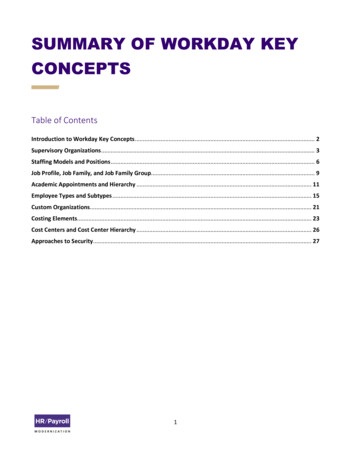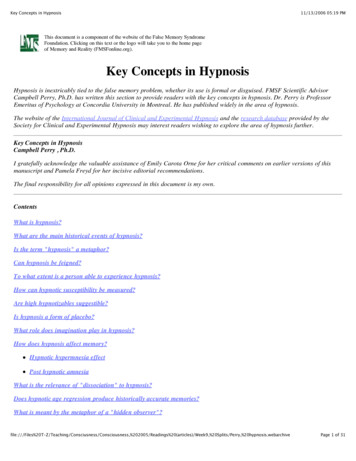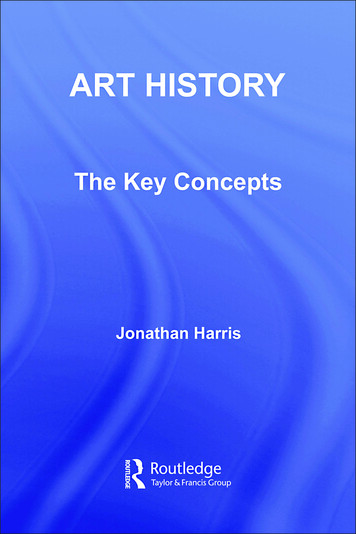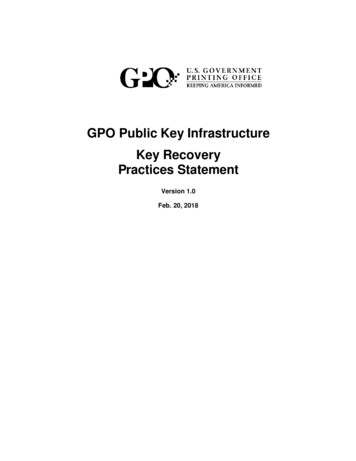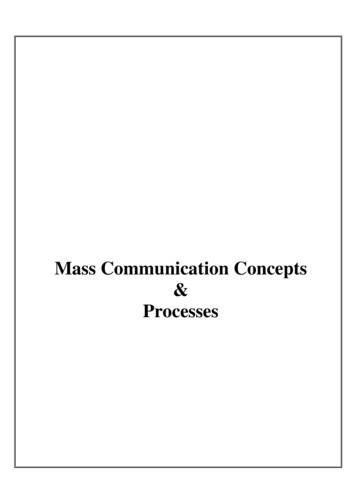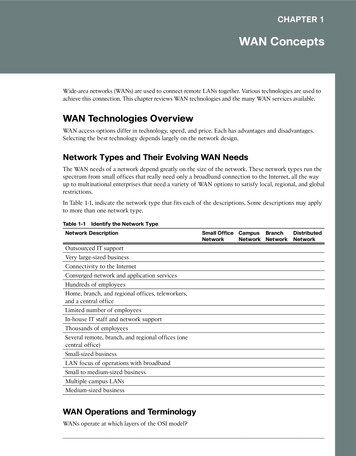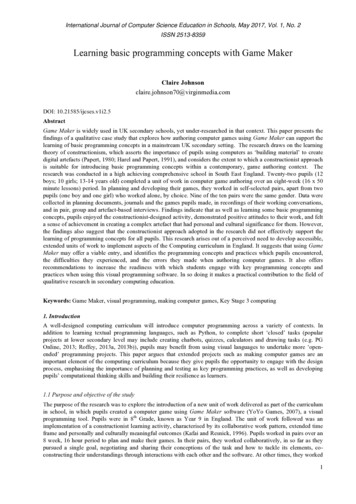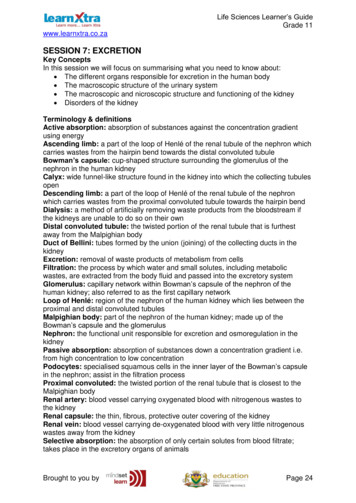
Transcription
Life Sciences Learner’s GuideGrade 11www.learnxtra.co.zaSESSION 7: EXCRETIONKey ConceptsIn this session we will focus on summarising what you need to know about: The different organs responsible for excretion in the human body The macroscopic structure of the urinary system The macroscopic and nicroscopic structure and functioning of the kidney Disorders of the kidneyTerminology & definitionsActive absorption: absorption of substances against the concentration gradientusing energyAscending limb: a part of the loop of Henlé of the renal tubule of the nephron whichcarries wastes from the hairpin bend towards the distal convoluted tubuleBowman’s capsule: cup-shaped structure surrounding the glomerulus of thenephron in the human kidneyCalyx: wide funnel-like structure found in the kidney into which the collecting tubulesopenDescending limb: a part of the loop of Henlé of the renal tubule of the nephronwhich carries wastes from the proximal convoluted tubule towards the hairpin bendDialysis: a method of artificially removing waste products from the bloodstream ifthe kidneys are unable to do so on their ownDistal convoluted tubule: the twisted portion of the renal tubule that is furthestaway from the Malpighian bodyDuct of Bellini: tubes formed by the union (joining) of the collecting ducts in thekidneyExcretion: removal of waste products of metabolism from cellsFiltration: the process by which water and small solutes, including metabolicwastes, are extracted from the body fluid and passed into the excretory systemGlomerulus: capillary network within Bowman’s capsule of the nephron of thehuman kidney; also referred to as the first capillary networkLoop of Henlé: region of the nephron of the human kidney which lies between theproximal and distal convoluted tubulesMalpighian body: part of the nephron of the human kidney; made up of theBowman’s capsule and the glomerulusNephron: the functional unit responsible for excretion and osmoregulation in thekidneyPassive absorption: absorption of substances down a concentration gradient i.e.from high concentration to low concentrationPodocytes: specialised squamous cells in the inner layer of the Bowman’s capsulein the nephron; assist in the filtration processProximal convoluted: the twisted portion of the renal tubule that is closest to theMalpighian bodyRenal artery: blood vessel carrying oxygenated blood with nitrogenous wastes tothe kidneyRenal capsule: the thin, fibrous, protective outer covering of the kidneyRenal vein: blood vessel carrying de-oxygenated blood with very little nitrogenouswastes away from the kidneySelective absorption: the absorption of only certain solutes from blood filtrate;takes place in the excretory organs of animalsBrought to you byPage 24
Life Sciences Learner’s GuideGrade 11www.learnxtra.co.zaSlit pores: tiny pores between the podocytes which form the lining of the Bowman’scapsule; the pores enable the podocytes to act as selective filtersTubular secretion: movement of waste substances, from the second capillarynetwork, into the renal tubule of the nephron in the human bodyUreter: the duct which conveys urine from the kidney to the bladderUrethra: tube transporting urine from the bladder to the exteriorDiagramsThe urinary systemAortaRenalarteryInferior vena cavaRenal veinKidneyUreterBladderSphincter muscleUrethraBrought to you byPage 25
Life Sciences Learner’s GuideGrade 11www.learnxtra.co.zaABDCEFGLongitudinal section of a human kidneyA – Renal capsuleB- CortexC- MedullaD- Renal veinBrought to you byE - PelvisF - CalyxG - UreterPage 26
Life Sciences Learner’s GuideGrade 11www.learnxtra.co.zaNephron and associatedblood vessels1 – Bowman’s capsule3 – Afferent arteriole5 – Proximal convoluted tubule7 – Distal convoluted tubule9 – Collecting tubuleBrought to you by2 – Glomerulus4 – Efferent arteriole6 – Descending limb of Henle8 – Secondary capillary networkPage 27
Life Sciences Learner’s GuideGrade 11www.learnxtra.co.zaAFBCDEA Malpighian bodyA – Afferent arterioleC – GlomerulusE – Proximal convoluted tubuleB – efferent arterioleD – Bowman’s capsuleX-planationWhat is excretion?Excretion, which is the removal of waste products formed by metabolism, ensuresthat these waste products (like CO2 and nitrogenous wastes) do not build up to toxiclevels.The different organs responsible for excretion in the human bodyExcretion organSubstance excretedOrigin of substanceexcretedLungsCO2 Water vapourCellular respirationKidneysUrine (Urea, Uric acid,Metabolic wasteWater, Salts, Ammonia)LiverBile pigments into theDead red blood cellsalimentary canalBladderUrineMetabolic wasteSkinSweat (H2O, Salts, Urea)Metabolic wasteThe macroscopic structure of the urinary systemThe urinary system consists of two kidneys, two ureters, the urinary bladder and theurethra.The renal artery carries blood to the kidney and the renal vein carries blood awayfrom the kidney.The renal artery, renal vein and ureter are attached to the kidney at its hilum.Brought to you byPage 28
Life Sciences Learner’s GuideGrade 11www.learnxtra.co.zaThe ureters begin within each kidney (the pelvis) and carry urine from the kidneys tothe bladder.The bladder stores urine temporarily.The urethra carries urine from the bladder to the exterior. In the male, the urethra,carriers urine as well as semen. In the female, the urethra and vagina openseparately.The structure and functioning of the kidneyInternal structure of the kidney:The kidney is covered and protected by the thin renal capsule. Within the renalcapsule is the outer cortex and inner medulla. The medulla is made up of a numberof cone-shaped pyramids. The pyramids have a number of tubes called the ducts ofBellini. The ureter extends into each kidney as a widened pelvis. The pelvisbranches into a number of calyces each of which encloses the apex of a pyramid.Embedded within each kidney there are about 1 million nephrons.The nephron:Consists of two parts:a) The Malpighian body Made up of cup-shaped Bowman’s capsule and the glomerulus The inner wall of the capsule is made up of specialised cells, thepodocytes. They form slit pores between them. The space between the inner and outer wall of the Bowman’s capsuleis called the capsular space.b) The renal tubule Consists of: proximal convoluted tubule, loop of Henlé (descendinglimb, ascending limb, hairpin bend) and distal convoluted tubule. The collecting tubules unite to form a duct of Bellini which runs throughthe pyramids and open into the calyces of the pyramids.Blood supply of the nephron: Renal artery afferent arterioles glomerulus efferent arteriole second capillary network venules renal veinBrought to you byPage 29
Life Sciences Learner’s GuideGrade 11www.learnxtra.co.zaFunctioning of the kidneyFunctionWhere it takes place1. Transport of bloodFrom the renal artery toto the glomerulusthe glomerulus2. Glomerular filtration(ultra-filtration)In the glomerulus3. Selective reabsorption(tubular reabsorption)At the:Proximal convolutedtubuleDistal convoluted tubuleParts of loop of HenléCollecting tubules4. Tubular excretionAlong the entire kidneytubule5. Transport of urine to Bladder and urethrathe bladder andurinationWhat happensBlood carrying useful andwaste substances iscarried to the glomerulusvia the afferent arteriole.All the substances in theblood, except bloodcorpuscles and proteins,are forced into thecapsular space ofBowman’s capsule.Water, salts, glucose andamino acids areselectively re-absorbed(by osmosis and activetransport) by the bloodcapillaries surrounding thetubules.Cells in the walls of thetubule excrete waste intothe blood capillaries.These substances includesalts, hydrogen ions andsome poisons.From the tubules the urinepasses into the pelvis andthen down the ureters intothe bladder. From time totime the bladder isemptied. The urinepasses along the urethrato the outside. Theprocess is called urination.The structural suitability of the nephron for its functions:a) Adaptations of the Malpighian body for its functions: The efferent arteriole is narrower than the afferent arteriole allowing apressure system to develop which is essential for filtration. The small size of the slit pores between the podocytes ensures that the bloodcorpuscles and large plasma proteins do not pass through into the capsularspace.(filtration) The Bowman’s capsule is cup-shaped allowing more close contact with theblood capillaries of the glomerulus for filtration. A single layer of endothelial cells of the capillary wall and a single layer ofpodocytes of the Bowman’s capsule form a thin surface for filtration. Large surface area of the capillary network of the glomerulus increases theefficiency of filtration. (many capillaries increase the surface area forreabsorption and excretion)Brought to you byPage 30
Life Sciences Learner’s GuideGrade 11www.learnxtra.co.za Pores on endothelium of the capillaries allow for a passageway of substancesduring filtration.b) Adaptations of the renal tubule for its functions: It is long and convoluted allowing sufficient time for re-absorption of usefulsubstances. (also increasing surface area) The second capillary network allows for the re-absorption of usefulsubstances and for excretion of waste substances into the tubules. The cells of the tubules are richly supplied with mitochondria providing energyfor active re-absorption to take place. The cells of the tubule have micro-villi to increase the surface area forexcretion and re-absorption. The sodium pump ensures that the medulla always has a high concentrationof salts ensuring that large amounts of water can be absorbed from the distaltubule and the collecting tubule by osmosis.(rephrase to include difference inwater potential/water potential gradient)Role of the kidney in osmoregulation:Less ADH secretedosmoreceptors inHYPOPHYSISstimulatedpermeability of renaltubule decreasesWater level rises* cold day* inactivity* high intake of fluids* less water re-absorbed* dilute urine is formed* more water is lostNormal waterlevel in bloodWater level drops* hot day* strenuous activity* low intake of fluidswater leveldropswater levelrises* more water re-absorbed* concentrated urine isformed* less water is lostosmoreceptors inHYPOPHYSISstimulatedpermeability of renalTubule increasesmore ADH secretedBrought to you byPage 31
Life Sciences Learner’s GuideGrade 11www.learnxtra.co.zaRole of the kidney in salt regulation:* more sodium ionsreabsorbed* less sodium ionsexcretedmore aldosterone secretedsodium level risessodium level decreasesNormalsodium levelin bloodsodium level increasessodium level dropsless aldosterone secreted* less sodium ionsreabsorbed* more sodium ionsexcretedDisorders of the kidneyDisease leading to kidney failureE.g. kidney stones, kidney infections, bilharziaDiseaseCauseSymptomsBilharziaBilharzia wormTirednessHeadachesSwollen liver andspleenTreatmentDrugs, e.g.praziquantelProtection of the kidneys:We can keep our kidneys healthy by: Drinking enough water Avoiding overuse of painkillers, anti-inflammatory drugs, Avoiding physical injuryDialysis:People with severe renal failure can be treated using an artificial kidney. An artificialkidney is a machine that uses the process of dialysis to purify the blood.Dialysis is the separating of small molecules such as urea from large molecules suchas proteins. A dialysis tube is used, through which the small molecules can diffuse.Brought to you byPage 32
Life Sciences Learner’s GuideGrade 11www.learnxtra.co.zaTwo or three times a week, a patient is connected to a kidney machine for three tosix hours. Blood is taken from a vein, usually in the arm, and pumped through hefine tubes in the artificial kidney and back into another vein. The fine tubes are madeof selectively permeable membranes. Dialysis fluid flows into the kidney machinearound these tubes and out again. The dialysis fluid contains salts, glucose andother blood plasma constituents in the same concentration as the blood, but containsno wastes. Dialysis occurs. Wastes such as urea diffuse from the blood into thedialysis fluid, which then leaves the machine.Advantages and disadvantages of kidney transplants and dialysis treatment:TreatmentAdvantagesDisadvantagesKidney transplantMore permanent solutionThe patient’s immuneto the problem.system might reject thetransplanted kidney.Very expensive.Dialysis treatmentCan be used for manyIt is expensive to travel toyears.the hospital to havedialysis.There is a high demand forthe machine.Patients need to live closeto a hospital that has adialysis machine.If the machine is notcleaned properly, patientscould catch blood-bornediseases.Brought to you byPage 33
Life Sciences Learner’s GuideGrade 11www.learnxtra.co.zaX-ample QuestionsQuestion 1(Adapted from Senior Certificate Examination, March 2004, Biology SG, Paper II,Question 4.2.2)Study the passage below and answer the questions that follow.Urine is formed by the nephrons. The two kidneys containapproximately two million nephrons. The basic function of thenephron is to "clean" or "clear" the blood plasma of unwantedsubstances as it passes through the kidney, while retaining in theblood those substances that are still needed by the body.(i) How many nephrons will there be in ONE kidney?(1)(ii) What is the basic function of a nephron?(1)(iii) Give any other function of the kidney apart from the functionmentioned in (ii).(1)(iv) Give any THREE useful substances which are retained in theblood.(v) Name THREE unwanted substances which will not bereabsorbed into the blood and eventually become part ofurine.(3)(3)Question 2(Adapted from Senior Certificate Examination, March 2004, Biology HG, Paper II,Question 5.1)The following graph indicates the concentrations of certain substances asthey move through the various regions of the nephron. Study the graph andanswer the questions that follow.Brought to you byPage 34
Life Sciences Learner’s Guide Grade 11 www.learnxtra.co.za Brought to you by Page 25 Slit pores: tiny pores between the podocytes which form the lining of the Bowman’s capsule; t
